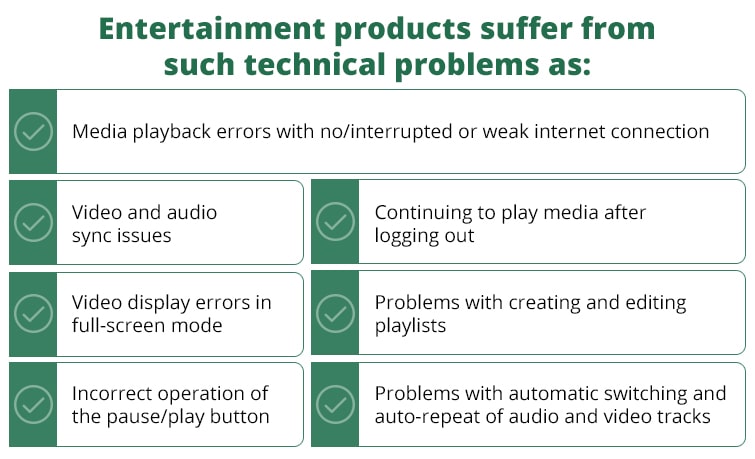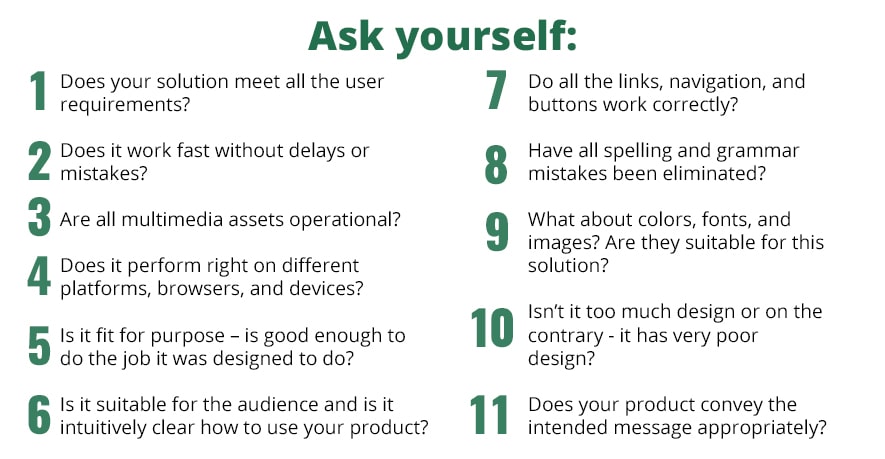5 pain points for multimedia software you can handle with software testing
by Yana Bozhko | June 9, 2021 12:57 pm
Hello. What symptoms bother you?
The global way to digitalization and last pandemic experience lead to massive migration to the online space, changing trends, and end-user needs. Being limited to outdoor entertainment and activities, people are looking for options in other channels, like the web. So new solutions are coming to market every day. According to PwC Global Entertainment & Media Outlook 2020-2024, revenues of the global media and entertainment industry are rising steadily which means it is getting harder to be ahead of the competitors.
Alongside applications of day-to-day tasks performing, an extensive range of media and entertainment solutions optimized to modern requirements has emerged. To reach a win-win solution, companies should consider trends amid consumers and innovative approaches to work. AI, OTT services, eSport, and voice streaming are getting more pervasive. All this makes developers of multimedia and entertainment products embrace novel software production approaches to stay at the top of the competition. And the most important – to do it fast.
Taking into account a huge amount of concurrents, it is important for multimedia solutions to be not only up-to-date but also stay good enough to do the job it was designed to do. And that is a huge “pain” for developers, especially when deadlines are burning.
In this field, positive or negative feedback from users decide who is on TOP. End users have become more fastidious in choosing entertaining applications because of thousands of options on the market.
And when you don’t have time for proper QA, or testing is done by developers (read [1]here[2] why it is not the best solution for your business), the painful disease spreads and causes more harm. And it looks like you need to call a doctor.
What should never be ignored?
So, it seems like we have a challenge here. Diagnosis is obvious: there are some pains in multimedia software and they need to be cured.
Despite the field of media and entertainment not being responsible for lives and guiding to certain standards, it is one of the most complex ones. It embraces dozens of content types and an extensive range of devices.
So what is the treatment?
Sorry, there is no magical panacea, but QA solutions can really help to reduce some pains.
Software testing helps get confident in the delivery of upscale and competitive products providing users with the software they expect to receive: high-qualitative, modern, intuitive, fast, well-designed, and cross-platform.
Even strict budget and time constraints can’t prevent QA introduction. And the reasons are simple: bugs in your product impact your business even more[3] than you think. So let’s find out what 5 pains of multimedia solutions can be solved with help of testing.
Pain #1: Technical challenges and missed errors
Another general challenge for multimedia developers is the existence of bugs that are easy to miss during production. Those are small content errors such as spelling mistakes or inaccurate information in changelogs, web pages, or read-me files.

Testing can help to ensure that your packaged software application is absolute, exact, and compatible by using different testing tools, methodologies, and approaches. Except functional and regression testing, the following testing types are performed for multimedia software:
- Usability testing
- Integration testing
- Configuration testing
- Load testing
- Recovery testing, etc.
This all helps to prevent most of those mistakes before launching the product or after bad reviews appear.
 [4]
[4]
Pain #2: Too large testing infrastructure
One of the main challenges for multimedia software is that it should interact with a lot of content types and on a wide range of different platforms and devices (especially mobile). As there is a tendency to use portable devices, it is important to perform mobile testing encompassing cross-platform and cross-browser testing. Harnessing real devices ensures glitches don’t appear on customers’ phones or tablets. You can’t follow all the types of tools and devices launching each day. But you can use the services of an independent QA provider to do those types of testing.
Usually, test labs contain a broad range of devices and end-user environments, encompassing different operating systems, desktop applications, video, and audio media players, and multimedia plug-ins.
Pain #3: We can’t release fast
Many developers think that testing only slows the process, but we are ready to turn over this point of view.
Fortunately, there are dozens of automated testing tools that make this process easier. Test automation accelerates the checking process of software solutions, decreases the number of QA engineers involved, and ensures the quality of your application without delaying the release.
It uses a scriptless approach[5] that involves tools that already have pre-ready written standard procedures you can use. No specific need to write long test scripts or select GUI-based commands. And proven software testing specialists understand the power of test automation very well. They design testing methodologies to ensure that every test that can be automated, is automated. This allows to execute regression testing early and often and enables software testers to devote greater time to tasks such as exploratory testing.
So the perfect combo will be if you leave enough time for such manual tests as verification of high-quality content performance, ease of use, and positive experience, but automate functional and regression tests. Eventually, it will not only accelerate the release but will help to make sure that the most important bugs are detected and fixed.
Pain #4: The product is not as popular as desired
An important point of user attraction in multimedia software production is providing your product with post-release support. The content for media software is constantly changing and developers need to respond very quickly to format vary, such as supported extensions, codecs, compatibility, licensing, etc. The more developers care about it, the higher the user’s loyalty to the product.
Also there is always another, external side of the solution, that you should think about because it influences highly on users’ opinions. They can ignore your product because of not user-friendly design, grammar mistakes, etc.
So if you want to attract more users, you need to deploy usability and GUI testing. Usability testing provides 360-degree visibility into how the customers see your applications and an understanding of the journey they pass through the product. GUI testing will help you to make the software more instinctive, recognizable, and high-quality.
Pain #5: Money losses on bugs fixing
Finding bugs is only half of the problem. After they are detected, you need to fix your product and launch an update. And usually, it causes time and money losses.
Shift-left testing can help. It is one of the progressive strategies in an Agile world. Putting testing activities at the very project start, companies can avoid expensive post hoc defect fixing and provide a robust ground for thorough testing.
Another advantage is that an optimized QA process is always supported with robust documentation, including checklists, test plans, test strategies, test cases, and bug reports. So you get a universal tool to systemize, monitor, and control all testing activities. It will help you to build an effective QA process for other products and new releases much faster and with optimized budgets.
The best recipe for you
Independent QA can solve your most painful software quality challenges, like the speed of testing, time to market, support costs, process optimization, and others.

First of all, QA specialists advise you to have a detailed QA test plan for your multimedia package. There are a variety of things that should be thoroughly tested.
To deal with it you can use the support of independent QA providers who have experience in your field.[6]
QA engineers already know what to test, can tap into your project very fast and test it from A to Z. The benefits of such a decision are obvious:
- You will get an independent observation of your product, suggestions on further enhancements, and comments on performance
- You will save the project budget because the sooner bugs are found – the less money will be spent on fixing them
- You will decrease negative feedbacks because of bugs
- You will get strong documentation to ensure effective QA and testing ahead of time.
- You will not have to expand your device fleet each time a new gadget comes out on market.
So if you are interested, we will provide you with more information. Please, contact us[7] to know more and to receive qualified QA help with your projects.
Learn more from QATestLab
Related Posts:
- read : https://blog.qatestlab.com/2020/02/18/developers-versus-testers/
- here: https://blog.qatestlab.com/2020/02/18/developers-versus-testers/
- impact your business even more: https://blog.qatestlab.com/2019/09/05/bugs-impact-business/
- [Image]: https://qatestlab.com/solutions/by-focus-area/mobile-applications/?utm_source=Blog&utm_medium=Post&utm_campaign=mobile-applications
- scriptless approach: https://blog.qatestlab.com/2020/03/04/scriptless-automated-testing/
- experience in your field.: https://qatestlab.com/resources/case-studies/media-and-entertainment/
- contact us: https://qatestlab.com/company/contact-us/
- Digital Transformation: What you need to know to succeed in 2020: https://blog.qatestlab.com/2020/04/22/digital-transformation-2020/
- The Power of Automation Testing: Magic Bullet or Smart Investment? (based on a case study): https://blog.qatestlab.com/2024/04/17/the-power-of-automation-testing-magic-bullet-or-smart-investment-based-on-a-case-study/
- What are the dangers of mistakes in accounting software?: https://blog.qatestlab.com/2022/05/11/mistakes-accounting-software/
Source URL: https://blog.qatestlab.com/2021/06/09/multimedia-software-testing/
 [4]
[4]
